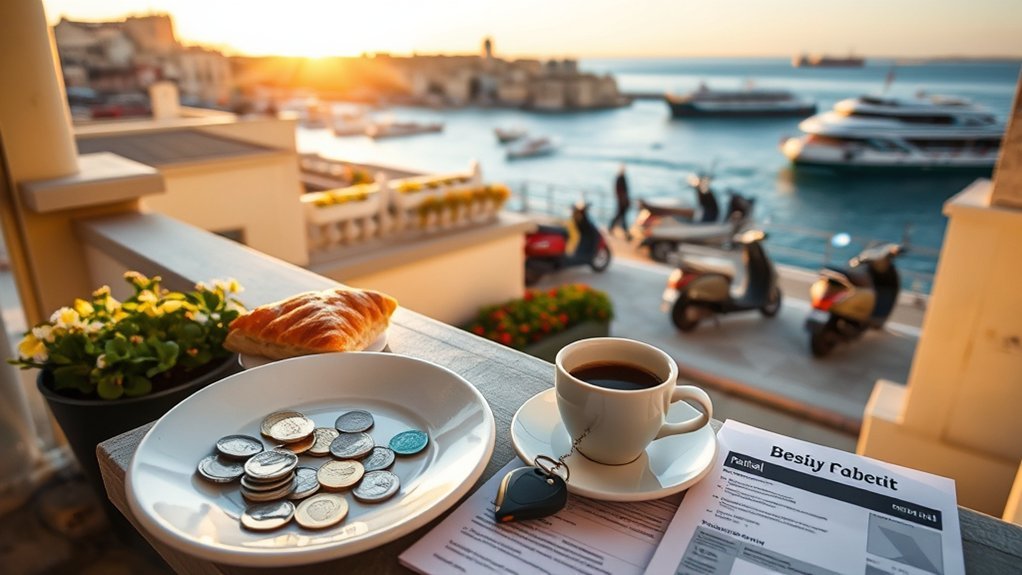You’ll typically need about €1,500–€1,600 a month to live comfortably in Malta as a single person, with rent the biggest variable. Expect non-rent living costs near €800, groceries roughly €400, and utilities €150–€200. Central one-bedroom rents average €700–€1,000, cheaper outside the centre. Public transport is affordable and internet about €34 monthly. Healthcare and schooling have mixed costs depending on public or private choices, and more specifics follow below.
Monthly Cost Breakdown for a Single Person in Malta
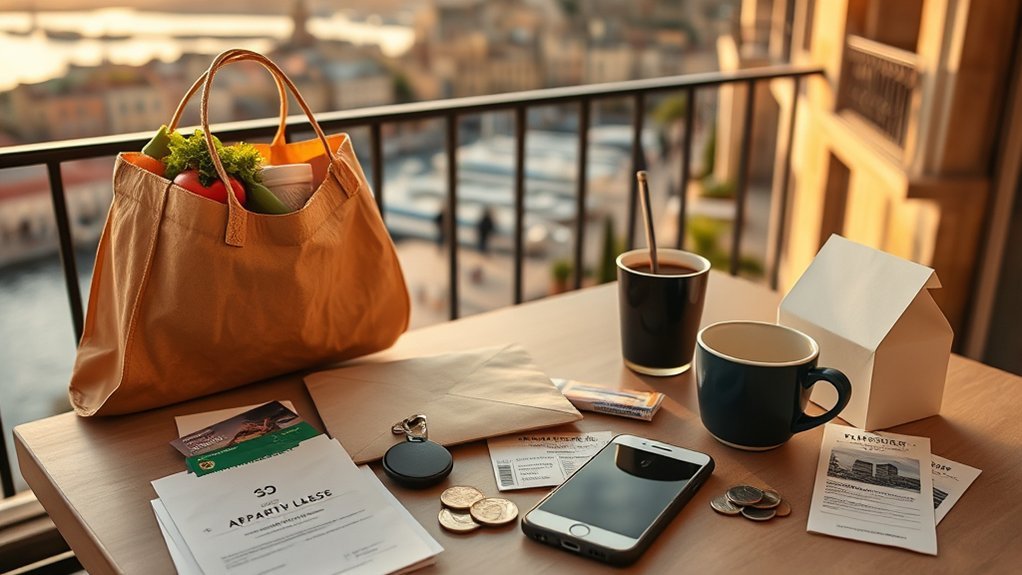
If you’re planning a single-person budget in Malta, expect monthly non-rent living costs of about €800 and add rent of roughly €834 in central areas (or €680 outside the center), bringing the typical total to around €1,558 per month.
You’ll see groceries at about €400 monthly (≈€100/week), utilities roughly €150–€200 though averaging near €84 for a moderate apartment, and internet plus mobile around €34.
That breakdown makes living expenses in Malta predictable: food and basics form the largest share, followed by rent and utilities.
Food and essentials make up the biggest slice of Maltese living costs, with rent and utilities close behind.
For monthly expenses planning, allocate roughly 51% to housing (when in central areas), 26% to groceries, 10% to utilities and services, and the remainder to transport, leisure, and incidentals.
Track receipts for a month to compare your actuals to these benchmarks, then adjust discretionary spending or location choice if totals exceed your target.
This gives you a data-driven snapshot to manage costs effectively.
Rent and Housing Prices Across Malta’s Regions
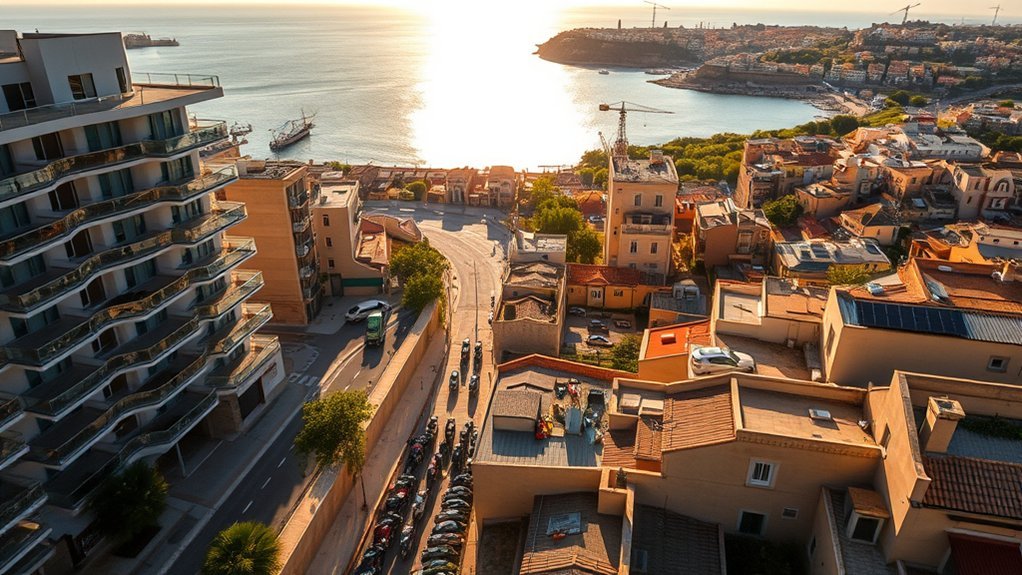
You’ll see clear differences between urban and rural rents: one-bedrooms run about €700–€1,000 in high-density areas and €500–€700 in southern regions and Gozo.
Compare buying versus renting by noting purchase prices from roughly €2,000 to €8,500 per m² against average rents of €1,000 for two-beds and €1,300+ for three-beds, plus the €14,000/year threshold for residency via leasing.
Don’t forget ongoing utilities and fees, which typically add about €150–€200 monthly for a standard apartment.
Urban Vs Rural Rents
While Malta’s rental market varies by location, you’ll generally pay more in high-density urban areas than in rural regions like Gozo or the southern towns.
You’ll see urban rents for a one-bedroom average €700–€1,000, while rural areas drop to €500–€700. A central two-bedroom runs around €1,000; in less populated zones you can find similar units from €800.
Premium urban locations (Sliema, Valletta) often push two-bedroom prices above €2,000, reflecting strong demand. Three-bedrooms typically start at €1,300 in urban centers and near €900 in remote areas.
Note that monthly utilities are fairly consistent—€150–€200 for an average apartment—so your location mainly affects rent, not basic running costs.
Buying Vs Renting
Considering your budget and lifestyle, should you buy or rent in Malta depends largely on location and long-term plans.
If you’re renting, expect one-bedroom rents of €700–€1,000 in central Sliema or Valletta and €500–€700 outside those areas; two-bedrooms run about €1,000 in dense areas and three-bedrooms start around €1,300. Southern Malta and Gozo offer lower rental rates.
If you’re buying, minimum investment is roughly €350,000 mainland (€300,000 in Gozo), with prices from €2,000 to €8,500 per m² depending on neighborhood.
Compare monthly rent plus typical utilities (€150–€200) against mortgage costs, taxes and resale prospects.
Short-term flexibility favors renting; long-term residency and equity growth can justify buying in central locations.
Utilities and Fees
Because utility costs and regional price differences directly affect your monthly housing outlay, you’ll want to factor both into any rent vs buy decision: one-bedroom rents run €700–€1,000 in central Malta and €500–€700 in places like Gozo, two-bedrooms average about €1,000 and three-bedrooms start at €1,300 (rising above €2,000 in high-demand neighborhoods), monthly utilities (electricity and water) typically add €150–€200, and basic internet/mobile plans are roughly €34 — while buying requires minimum investments of €350,000 on the mainland (€300,000 in Gozo) with per‑m² prices from €2,000 to €8,500.
You should budget utilities and fees into your Cost of Living calculation. Rents vary by region; buying needs significant capital. Use this quick reference:
| Item | Typical Monthly | Purchase Benchmark |
|---|---|---|
| One-bed / Two-bed | €500–€1,000 / €1,000 | n/a |
| Utilities + Internet | €184–€234 | n/a |
| Property buy | n/a | €300k–€350k (min) |
Utilities, Internet and Household Bills Explained
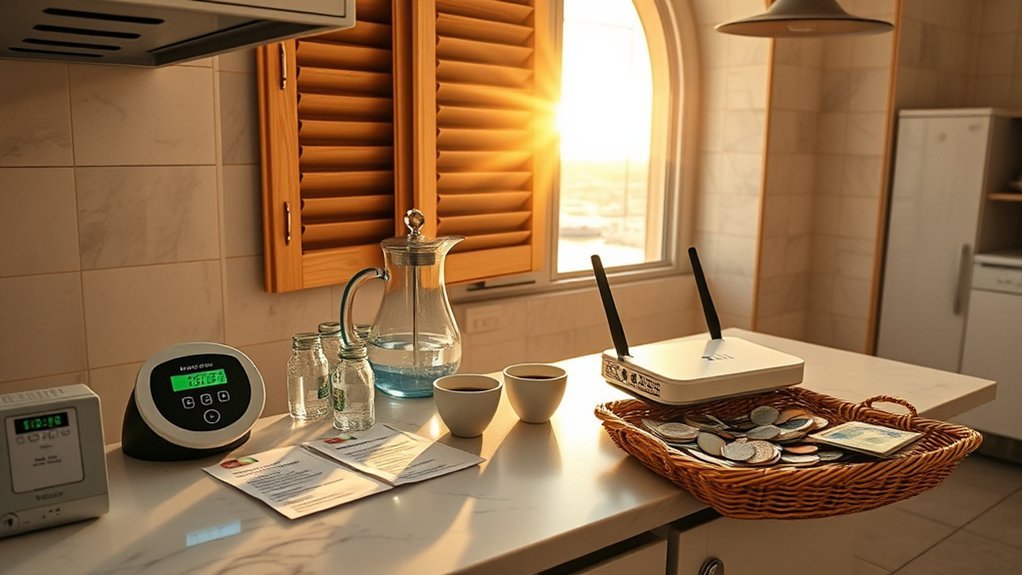
Expect monthly utilities for an 85 m² apartment to run about €150–€200, covering electricity, water and basic services.
Electricity is roughly €0.144/kWh, and many homes use split A/C-heat units to keep consumption down.
High‑speed broadband is about €34/month while mobile calls cost roughly €0.30/min, so factor both fixed and usage charges into your monthly budget.
Monthly Utility Costs
When you budget for utilities in Malta, plan on about €150–€200 a month for an average apartment to cover electricity, water and gas; electricity alone runs roughly €0.144 per kWh, and many households buy bottled water because desalinated tap water often isn’t preferred for drinking.
Your monthly utility costs will consequently depend on usage patterns: heavy air-conditioning or electric heating pushes the higher end, while moderate use keeps you near €150.
Expect predictable fixed charges plus variable consumption fees; monitor meter readings monthly to control expenses.
If you’re cost-conscious, reduce peak-time consumption, use LED lighting, and maintain appliances.
These practical steps impact your bills directly, making it easier to forecast and stick to your household expenses.
Internet and Mobile Plans
How much will internet and mobile service add to your monthly bills? High-speed broadband internet in Malta runs about €34/month, so you can budget that as a fixed cost.
Mobile plans vary; pay-as-you-go call rates are roughly €0.30/minute, so choose a data-focused plan if you talk less and use more data.
Factor these alongside utilities (electricity ~€0.144/kWh; total utilities €150–€200/month).
Practical breakdown:
- Broadband: ~€34/month for reliable high-speed internet.
- Calls: ~€0.30/minute — consider bundled minutes or unlimited options.
- Utilities context: €150–€200/month; electricity rate affects total.
- Water: desalinated and safe, but bottled water may add to groceries.
Compare mobile plans for data vs. minutes to optimize your monthly spend.
Grocery Shopping and Typical Food Expenses
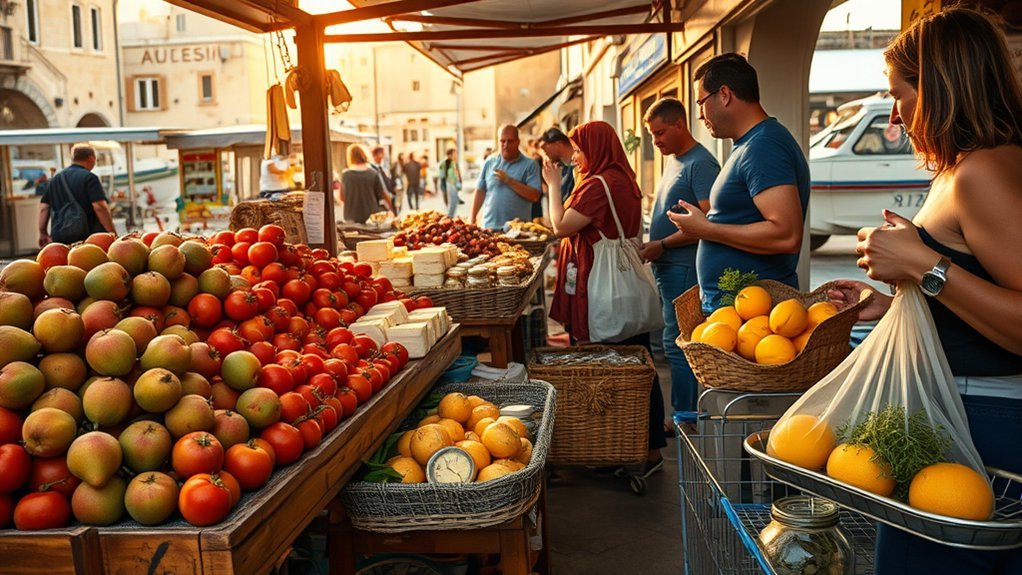
Although grocery prices in Malta vary by store and season, you can plan on roughly €100 per week for a healthy single-person diet.
For grocery shopping, you’ll find chains like Wellbee’s, Lidl and Marks and Spencer Food cover basics and branded items at competitive prices. Expect a 12-pack of eggs around €3.60 and a litre of milk near €1; those staples help keep weekly totals predictable.
If you shop seasonal produce and local markets, you’ll lower food expenses further—fresh fish at Marsaxlokk can be very economical (about €30 for 6 kg), so buying in bulk or sharing cuts costs.
Compare unit prices, use store loyalty offers, and buy own-brand goods for savings. Plan menus around on-sale proteins and frozen vegetables to reduce waste.
With attentive shopping and simple meal planning, you’ll stay within the €100 weekly estimate while eating well in Malta.
Eating Out, Cafes and Nightlife Costs
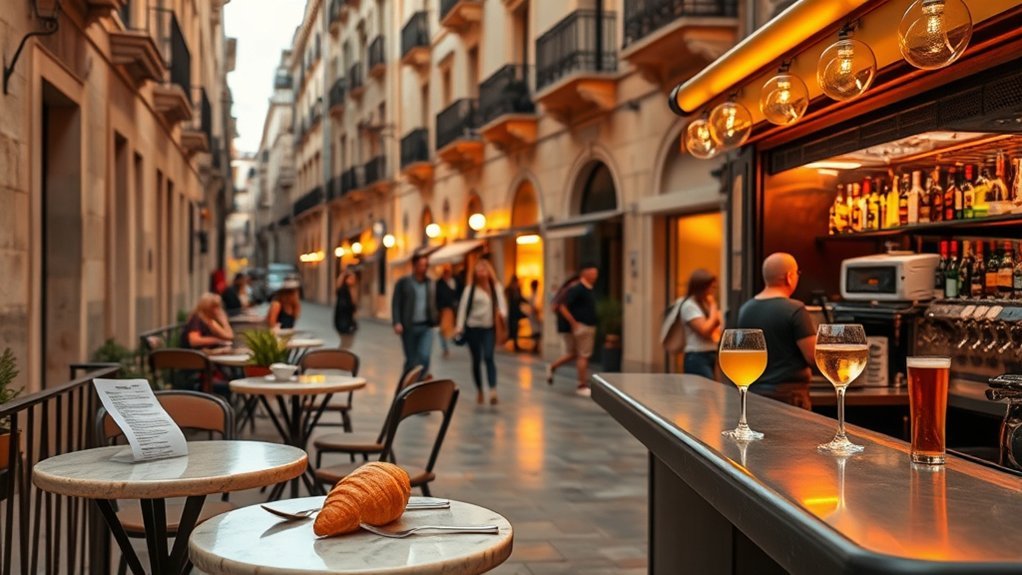
You’ll find a three-course meal for two at a mid-range restaurant costs about €70, while inexpensive local meals average €15 and Michelin-starred dining runs €70–€100 per person.
A cappuccino is roughly €2.20 at most cafés, and cinemas are around €9 per adult with family passes from €20.
Bars and clubs vary widely—expect modest cover charges in popular venues and lower prices at local spots and markets that offer affordable nightlife options.
Typical Meal Prices
One mid-range three-course meal for two costs about €70, while inexpensive restaurants average €15 per person, so you can plan meals based on budget and occasion.
For typical meal prices, you’ll find options that cost around a wide range depending on venue and formality. Use this quick breakdown to budget weekly dining or nights out:
- Fast-food meal: around €8 — good for quick, low-cost lunches.
- Café/casual eatery meal: €10–€20 — versatile for light meals or casual dinners.
- Mid-range dining: €35 per person (three courses split for two ≈ €70) — predictable for date nights.
- Michelin-starred experience: €70–€100 per person — plan for special occasions and premium tasting menus.
Coffee and Café Culture
When you grab a cappuccino in Malta, expect to pay about €2.20 on average, which makes daily café visits an affordable part of your routine; at that rate, a cup every day adds roughly €66 to your monthly expenses.
You’ll find coffee widely available in neighbourhood cafés where cost stays low, but prices climb 10–20% in tourist hubs like Valletta.
If you choose to eat while you sip, an inexpensive restaurant meal averages €15 and a mid-range three-course for two about €70, so factor those into occasional café lunches.
For evening outings, a cinema ticket runs about €9, offering low-cost entertainment separate from bar and club spending.
Track frequency to control your weekly and monthly budget.
Bars, Clubs, Entry Fees
Although Malta’s nightlife can be affordable, your costs will vary by venue and frequency: drinks at bars generally run €5–€10 each, club or bar entry is usually €5–€15 depending on events, and a mid-range dinner is about €30 per person (or €70 for a three-course meal for two).
You’ll want to budget based on how often you go out. Consider typical expenses:
- Weekly drink outing (2 drinks at €7 each): €14.
- Monthly club visit (entry €10 + drinks €20): €30.
- Regular dinners out (mid-range €30 per person): €60 for two.
- Daily coffee habit (cappuccino €2.20): ~€66 monthly.
Use these benchmarks to project a realistic nightlife budget; adjust for peak-season events or upscale venues where costs rise.
Transport: Buses, Ferries, Taxis and Driving Expenses
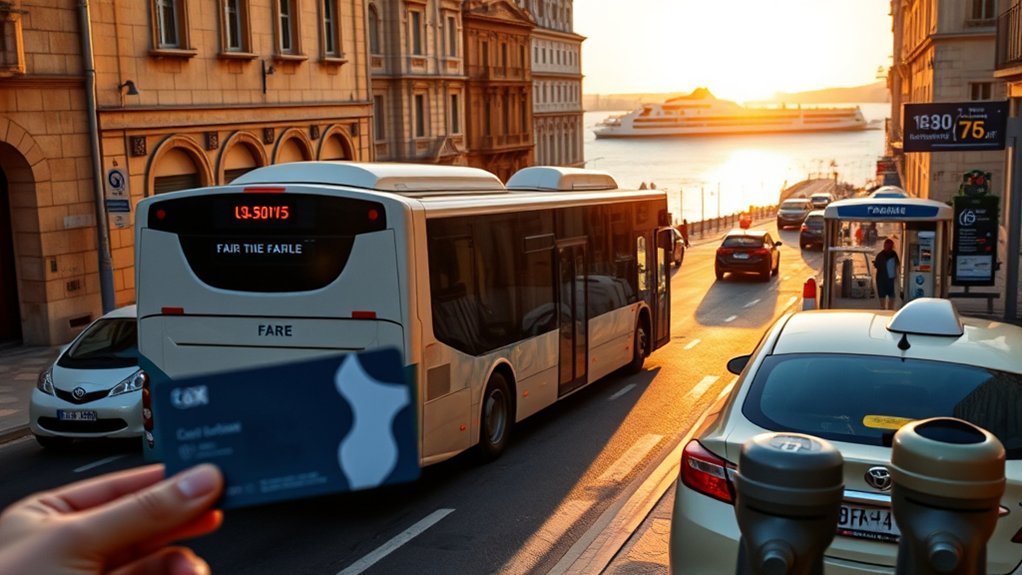
Public transport in Malta is affordable and straightforward: daytime bus fares are €2.50 (€3.00 at night), while a Tallinja 7‑day commuter card gives you unlimited travel for €25.
Ferries to Gozo and Sicily charge under €2.50 for foot passengers (about €20 for a car). You’ll find the bus network extensive and simple to use; if you commute regularly, the €25 weekly card cuts costs considerably versus single fares.
Ferries are cheap for foot passengers and practical for day trips; car transport to Gozo or Sicily runs about €20.
Taxi fares start at €5 for the first kilometre, then roughly €2 per additional kilometre, so a Valletta–St Julian’s trip typically costs €19–€25 — useful late at night or with luggage.
Renting a car begins around €16 per day, petrol is about €1.40/L, but factor in annual insurance (~€1,600) and registration (~€72) when evaluating driving expenses.
Healthcare, Insurance and Medical Fees for Expats

After you’ve figured out transport costs, you’ll want to plan for healthcare and insurance, which can materially affect your monthly budget. Malta has public and private healthcare; citizens and EU nationals with a health insurance card (EHIC) access low- or no-cost services. Non-EU expats must buy private cover.
- Public vs private: Malta ranks 11th by WHO and spends ~10% of GDP on healthcare; public care is high quality and economical.
- Costs for visits: GP appointments typically cost €10–€60; specialist visits €50–€60.
- Insurance pricing: Extensive private plans for two people in their 60s start around €2,500 annually; younger, cheaper options exist.
- Medications: Prescriptions are generally affordable, though prices vary by drug.
You should compare private plan benefits, exclusions, deductibles and provider networks, and keep your EHIC if eligible.
Budget for routine visits, occasional specialists and prescription copays when estimating monthly living costs.
Education Costs: Childcare, Private Schools and Universities

When you’re planning for children, factor in that free public schooling is available to foreign children with residency and work permits.
However, many expat families choose paid options: private kindergarten runs about €400–€600 per month, private school tuition starts around €8,000 a year, and higher education for foreign students typically ranges from €5,000 to €25,000 annually depending on program and institution.
You can enroll kids in free public schools if you meet residency/work requirements, which keeps education costs low.
If you prefer private schools, expect English-medium options, structured curricula, and extra fees for uniforms, transport and activities.
Private kindergarten gives early-years care and faster integration but adds monthly costs to your budget.
For university, compare programs: EU-equivalent fees and specialized degrees push costs toward the higher end.
Factor scholarships, part-time work rules, and living expenses when forecasting total higher-education expenditure.
In short, budget realistically across childcare, private schools and universities to avoid surprises.
Comparing Malta’s Cost of Living With Other Countries
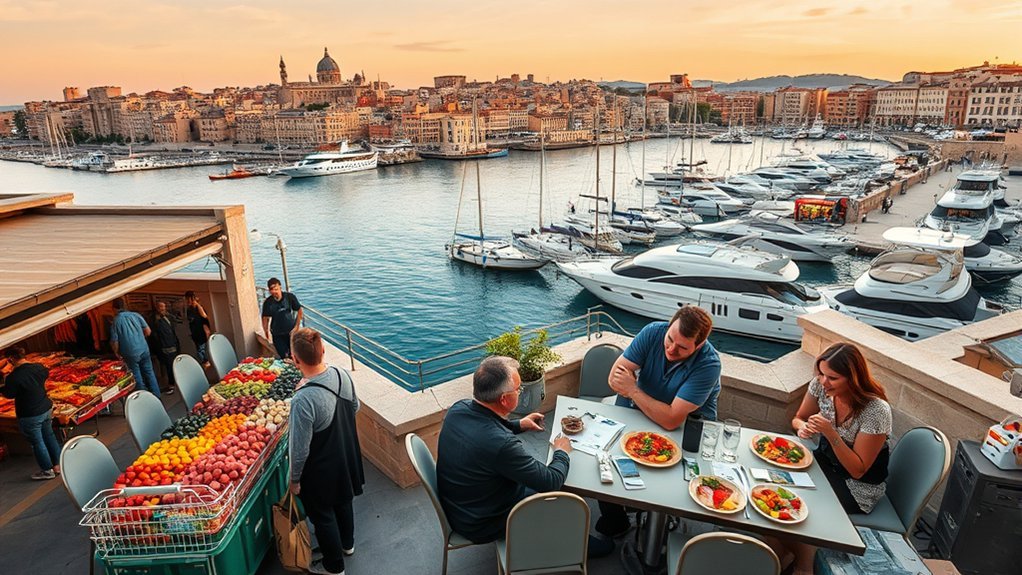
Although smaller and more compact than many countries you might be comparing it to, Malta delivers noticeably lower everyday costs: overall living expenses run about 39% below U.S. levels and roughly 12.4% below the EU average.
That gap matters when you evaluate budgets for permanent residence, retirement, or working abroad. You’ll find housing and daily spending consistently cheaper without sacrificing services.
- Housing: one-bedroom downtown ≈ €778/month (about half U.S. €1,483).
- Food: monthly groceries ≈ €429 vs. U.S. €568.
- Transport: monthly public transit ≈ €54.90 vs. U.S. €98.
- Overall: consumer prices ≈ 12.4% below EU average.
Use these benchmarks to compare net salaries, tax rates, and personal priorities.
If you value lower rental and routine costs, Malta’s cost of living gives you more disposable income than many U.S. and several EU alternatives, making it a pragmatic option to contemplate for long-term relocation.
Residency, Property Investment and Relocation Expenses
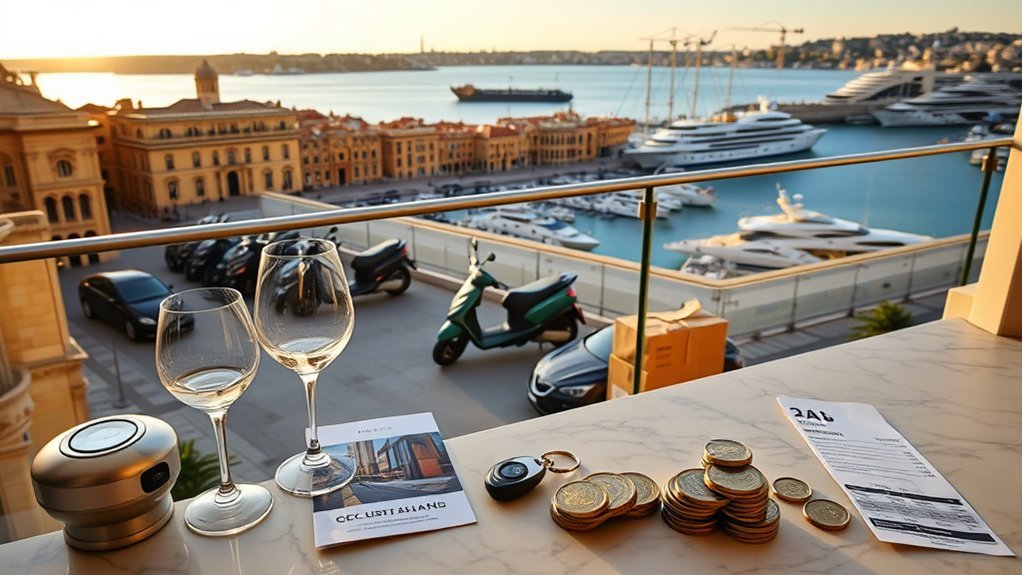
Lower everyday costs make Malta attractive, but you’ll need to budget for residency and property expenses before you move.
If you aim for temporary residency, plan to rent at least €14,000/year or buy property from €375,000; permanent residency requires €16,000/year rent or purchases starting at €700,000.
Property investment prices vary widely—€2,000–€8,500/m²—so location drives total cost. Expect one-bedroom central rents around €800–€1,000/month, aligning with average single-person monthly living costs of about €800 (families €3,100, excluding rent).
The PR Card process typically takes 4–6 months; factor legal, application, and due-diligence fees, plus potential investment options if you pursue citizenship by naturalization.
For relocation, add movers, temporary accommodation, and initial setup—usually several thousand euros depending on volume and service level.
Use these figures to model scenarios: rent-first to test the market, or calculate mortgage and purchase taxes if you commit to property investment and residency long-term.
Frequently Asked Questions
How Much Does It Cost to Live in Malta in US Dollars?
You’ll spend about $1,836 monthly in Malta; this cost breakdown covers rent, utilities, groceries, and internet. Your lifestyle expenses vary by location and habits, but overall living costs are roughly 39% lower than in the USA.
Can a US Citizen Live in Malta?
Yes — you can live in Malta if you meet visa requirements and obtain appropriate residency permits; you’ll need to show sufficient funds, valid health insurance, a clean criminal record, and expect processing to take weeks to months.
How Much Does a House in Malta Cost?
Prices vary: you’ll pay roughly €2,000–€8,500 per sqm for property prices, meaning typical homes run €300,000–€1,000,000+; you’ll also watch the rental market for €500–€1,000 monthly, guiding investment decisions.
Is Malta More Expensive Than the USA?
No — Malta’s cheaper: your cost comparison shows living expenses about 39% lower than the USA, with cheaper housing (≈$778/month), food (≈$429), and transit (≈$54.90), though insurance needs can vary.
Conclusion
You’ll find Malta’s costs vary by lifestyle and location, but you can plan confidently: expect rent and utilities to dominate, groceries and dining to be moderate, and healthcare affordable with private insurance. Factor childcare or tuition if relevant, and budget for residency or property fees when relocating. Compare wages and taxes to your home country to see real affordability. Think of Malta as a modern island with the old-world charm of a pocket watch—practical, predictable, and worth the move.

